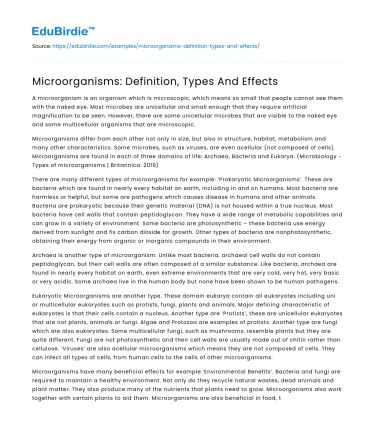A microorganism is an organism which is microscopic, which means so small that people cannot see them with the naked eye. Most microbes are unicellular and small enough that they require artificial magnification to be seen. However, there are some unicellular microbes that are visible to the naked eye and some multicellular organisms that are microscopic.
Microorganisms differ from each other not only in size, but also in structure, habitat, metabolism and many other characteristics. Some microbes, such as viruses, are even acellular (not composed of cells). Microorganisms are found in each of three domains of life: Archaea, Bacteria and Eukarya. (Microbiology - Types of microorganisms | Britannica. 2019)
Save your time!
We can take care of your essay
- Proper editing and formatting
- Free revision, title page, and bibliography
- Flexible prices and money-back guarantee
There are many different types of microorganisms for example: ‘Prokaryotic Microorganisms’. These are bacteria which are found in nearly every habitat on earth, including in and on humans. Most bacteria are harmless or helpful, but some are pathogens which causes disease in humans and other animals. Bacteria are prokaryotic because their genetic material (DNA) is not housed within a true nucleus. Most bacteria have cell walls that contain peptidoglycan. They have a wide range of metabolic capabilities and can grow in a variety of environment. Some bacteria are photosynthetic – these bacteria use energy derived from sunlight and fix carbon dioxide for growth. Other types of bacteria are nonphotosynthetic, obtaining their energy from organic or inorganic compounds in their environment.
Archaea is another type of microorganism. Unlike most bacteria, archaeal cell walls do not contain peptidoglycan, but their cell walls are often composed of a similar substance. Like bacteria, archaea are found in nearly every habitat on earth, even extreme environments that are very cold, very hot, very basic or very acidic. Some archaea live in the human body but none have been shown to be human pathogens.
Eukaryotic Microorganisms are another type. These domain eukarya contain all eukaryotes including uni or multicellular eukaryotes such as protists, fungi, plants and animals. Major defining characteristic of eukaryotes is that their cells contain a nucleus. Another type are ‘Protists’, these are unicellular eukaryotes that are not plants, animals or fungi. Algae and Protozoa are examples of protists. Another type are fungi which are also eukaryotes. Some multicellular fungi, such as mushrooms, resemble plants but they are quite different. Fungi are not photosynthetic and their cell walls are usually made out of chitin rather than cellulose. ‘Viruses’ are also acellular microorganisms which means they are not composed of cells. They can infect all types of cells, from human cells to the cells of other microorganisms.
Microorganisms have many beneficial effects for example ‘Environmental Benefits’. Bacteria and fungi are required to maintain a healthy environment. Not only do they recycle natural wastes, dead animals and plant matter. They also produce many of the nutrients that plants need to grow. Microorganisms also work together with certain plants to aid them. Microorganisms are also beneficial in food, they are important partners when it comes to the work of creating food. They can be used to increase the fertility of the soil and increase crop yields and they are necessary when making products like bread, beer and cheese.
Microorganisms also have bodily benefits. Microorganisms known as gut flora help us digest food and regulate the production of vitamins and nutrients essential to keeping our bodies strong and healthy. Bacteria are the first line of defence the human body has against infection. The bacteria in our bodies produce natural antibodies to repel harmful microorganisms. They can also have ‘Medical Benefits’ – We regularly aid the microorganism in our bodies by adding more. Certain species of microorganisms can make you sick e.g. Strep throat and the flu. Modern medicine would not exist if it wasn’t for the careful study of microorganisms. Today microorganisms allow us to artificially grow helpful substances such as insulin and human growth hormones.
Just like having beneficial effects there are many harmful effects of microorganisms such as; Pathogenicity – these microbes have ability to cause infections destroy host and transmit to the next possible host. Another harmful effect could be antibiotic resistance – many strains of bacteria are resistant to antibiotics which were developed as inappropriate use of antibiotics against viruses and bacteria. A common harmful effect of microorganisms is food poisoning. Bacteria and viruses are the most common cause of food poisoning. Some cases of food poisoning can be linked to either natural toxins or chemical toxins. While some molds are desirable in foods, other molds can produce toxins that cause illness. Harmful effects can come from food spoilage. Bacteria and fungi species are well known to cause food spoilage as they get enough nutrients and grow their release their contents and make food unfit for eating. There can also be harmful effects from biological warfare.
References
- https://www.britannica.com/science/microbiology/Types-of-microorganisms
- Siyavula.com/read/science
- Courses.lumenlearning.com/types-of-microorganisms
- Sciencing.com
- Quora.com






 Stuck on your essay?
Stuck on your essay?

